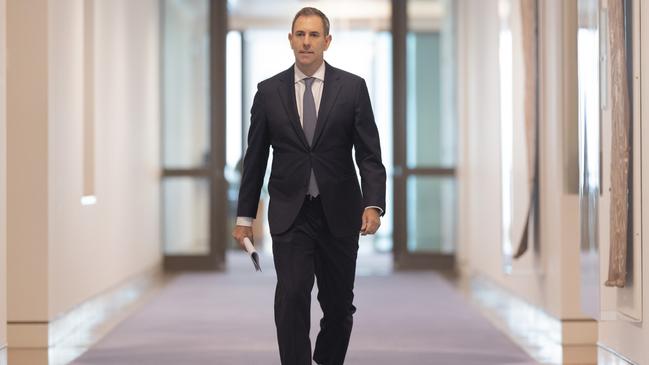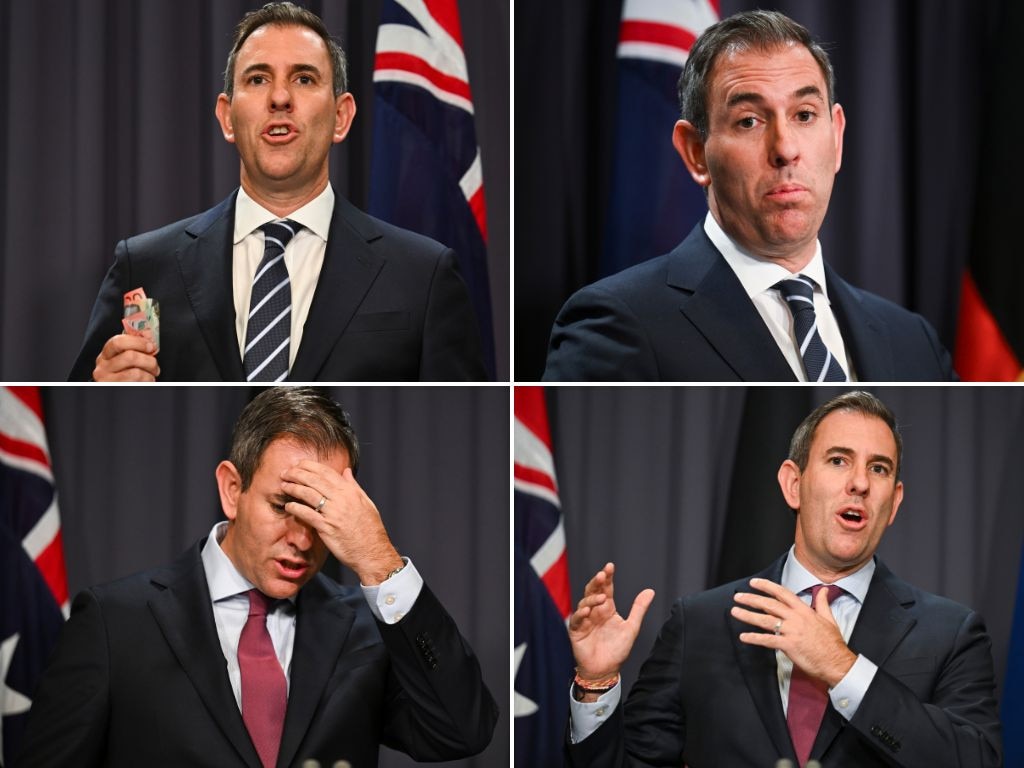‘Automatic’ excuse to justify Labor spending
Jim Chalmers’s budget update will bake-in $25.1bn in extra expenditure, with some leading economists declaring Labor’s financial path is not inevitable and offsets can still be made.

Jim Chalmers’s budget update will bake-in $25.1bn in extra expenditure underwriting what the government claims is “unavoidable and automatic” spending,with some leading economists declaring Labor’s financial path is not inevitable and offsets can still be made.
Amid worsening structural budget pressures, Finance Minister Katy Gallagher on Tuesday will reveal the mid-year economic and fiscal outlook includes $16.3bn to cover the cost of increased welfare payments and pensions, cost-of-living supports and childcare subsidies.
In the May budget, the Treasurer abandoned future surpluses in favour of “unavoidable” spending on deals with the states worth tens of billions of dollars, wage rises for low-paid workers and cost-of-living relief.
The government doubled down on the “unavoidable spending” argument on Monday ahead of MYEFO, and also said there was now “automatic spending” based on more people accessing government payments.
Senator Gallagher said the spending was necessary to avoid cuts to services. “We are doing the right thing by our veterans, pensioners, school kids and Australians who rely on essential health programs, but the Coalition’s plan to cut $315bn in spending would see cuts across all of these areas.”
Economist Chris Richardson dismissed claims the extra outlays couldn’t be avoided, saying governments “absolutely have a choice” to increase their expenditure. “I have no problem with the government identifying and funding their priorities,” he said. “But if you’re spending more or cutting taxes, you need to offset those decisions elsewhere.”
As Dr Chalmers manages an $8.5bn writedown in company tax receipts and a $100bn hit to mining exports, Senator Gallagher said the MYEFO on Wednesday would show $14.6bn in “additional savings and reprioritisations”.
While the Albanese government claims it has banked $92bn in savings and reprioritisations since the 2022 election, a large chunk of savings has been shifted into spending across other priority government programs.
Mr Richardson estimates that in Dr Chalmers’s first four budgets, the Albanese government spent an extra $104bn but raised only $44bn in extra revenue, resulting in a $60bn structural deterioration in the budget bottom line.
The MYEFO will include $16.3bn in increased spending owing to so-called “parameter variations” covering pensions, childcare subsidies and medical services. These are changes to the government’s expenditure outside its control, such as indexation of payments due to inflation and increased demand for government services, which are applied from budget to budget.
Alongside the “automatic” spending increases, Senator Gallagher foreshadowed $8.8bn in “unavoidable spending”, which she claimed would ensure government services and programs were not cut. This includes further funding commitments for the Pharmaceutical Benefits Scheme and National Disability Insurance Scheme. Offsetting some of the increased expenditure will be the Albanese government’s efforts to contain the ballooning cost of aged-care services after Labor and the Coalition struck a deal in September to ensure the system’s long-term financial sustainability.
Labor’s changes to overhaul the user-pays framework for residential and at-home care is forecast by the Treasury to reduce the $157.6bn price tag of aged-care services over the four-year forward estimates period by $5.2bn.
Yet even with Labor’s reforms, aged care will continue to remain among the top five most expensive line items in the federal budget, alongside payments to the states and territories, the Age Pension, the National Disability Insurance Scheme, and medical benefits.
The mid-year budget update will also reveal the reprioritisation of $1.6bn in defence spending as the government struggles to dispense funds due to delays on big ticket projects. Instead, the funding will be directed towards training and retention of ADF personnel.
The details of a further $7.8bn in savings and reprioritisations will be released in Wednesday’s update.
Amid sluggish growth in the Chinese economy, the MYEFO is expected to show a deepening of budget deficits in coming years, ending the run of back-to-back surpluses built on post-pandemic surges in migration, commodity prices and employment.
While Dr Chalmers has banked consecutive surpluses, Treasury forecasts in the May budget flagged an underlying cash deficit of $28.3bn this year.
Dr Chalmers on Monday said global economic volatility was weighing on the federal budget. “Despite all of this global economic uncertainty, despite the pressures on our economy from cost of living and from higher interest rates, what we’ve seen over the first 2½ half years of this government is two surpluses and much less debt,” he said.
Opposition Treasury spokesman Angus Taylor, who is yet to unveil the Coalition’s tax and spending plans, accused Dr Chalmers of shifting blame to Xi Jinping, Vladimir Putin and Donald Trump for the state of budget.
Mr Taylor said it was the government’s job to contain spending growth and end “reckless spending” that economists warn will “see a massive budget deficit this year, and indeed well over $200bn of deficits in the coming four years in the headline budget”.
“There is much the government can do to strengthen the economy, to strengthen the budget, and the first thing they could do is stop the reckless growth in spending. We’re seeing a rapid growth in spending,” he said.
“That’s why we’ve opposed over $100bn of spending through the budget because now is not the right time for an Australian government to be growing spending at a much faster pace than the economy. Labor has always blamed any woes on someone else … The truth is that they have lost control of spending. The reckless spending goes on and the result of that is that they’re driving the budget into a big deficit.
“There is much the government can do to strengthen the economy, to strengthen the budget, and the first thing … is stop the reckless growth in spending.”
Amid expectations of further expenditure in the lead-up to the election, which must be held on or before May 17, Mr Richardson warned against the recent surge in so-called “off-budget” spending, which had allowed governments of all political persuasions to hide the depth of their budget deficits.
“When you’ve got stuff that won’t pay its way, governments just hide it there and hope it doesn’t get the scrutiny it deserves,” Mr Richardson said, pointing to the National Broadband Network and Labor’s plan to forgo $16bn in student HELP debt repayments. “The [headline] deficits we are getting are $20bn worse than the [underlying cash balance] being widely reported.”
While both Labor and the Coalition have historically listed off-budget measures, Labor has significantly ramped up such outlays since coming to government, concealing the impact of the additional spending on the bottom line.
In then-treasurer Josh Frydenberg’s final budget in March 2022, off-budget spending was projected at $33.7bn over five years. In Dr Chalmers’s May budget, that figure had climbed to $80.5bn following the establishment of a range of energy and infrastructure investment vehicles, including the Future Made in Australia plan.






To join the conversation, please log in. Don't have an account? Register
Join the conversation, you are commenting as Logout